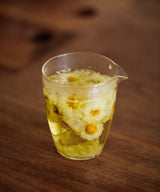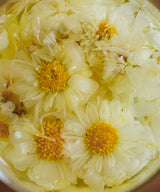Silk Chrysanthemum Cake
有机蚕丝杭白菊
Harvest
November 2024
Origin
Tongxiang, Zhejiang
Medicinal, citrusy, intensely pretty and potent: freshly pressed Silk Chrysanthemum Cake has arrived and its tasting more powerful than ever. For those of you who have yet to try this spectacular tea, this is the year to come bask in its pristine, bright yellow, sun-like glory. This is a very supportive tea to enjoy in the summer season, as it clears heat from the body and smooths circulation.
To make this masterpiece, each chrysanthemum flower is harvested carefully by hand in the morning. At night, they are processed using a centuries-old traditional steaming method. Wood from local camphor trees is used to start a fire. Small batches of 100 grams of fresh flowers are placed inside hand woven bamboo baskets, then steamed for 4 to 5 minutes over the fire. The chrysanthemums naturally form into a “cake” after steaming. The pressed flowers remain vibrant yellow, like rays of the sun. To finish, the tea cakes are baked for 4 to 6 hours to remove any remaining moisture.
To brew this tea you will break some pieces of the flower cake off before putting them in a glass pitcher to add water. As soon as hot water hits them they tint the liquor a soft yellow. Then the flowers expand, and expand, opening to reveal their plush petals and golden pistils. The flowers fill the glass pitcher with a beautiful mess, like a drowned bouquet.
The tea has the sweetest aroma, and its flowery citrus notes captivate us the way yuzu, valencia orange, or bergamot does. The powerful medicinal qualities of this tea are noticeable when drinking it. It has a clearing effect that we feel draining heat and stagnation from the body. It is so delicious, you will smile while it works its magic on you.
Silk Chrysanthemum is a product born out of love and respect for traditions, heritage, and nature. It is an embodiment of everything that Cultivate stands for: passionate artisans, heirloom varietals with history, biodynamic and natural farming methods, and craftsmanship adhering to traditions and cultures that have been passed down for generations.
. . .
Brewing guide
| Tea | 3g |
| Temperature | 100 °C |
| Water | 200 ml |
| Steep time | 3 min, 5 min, 5 min |
| No. of infusions | 3 |
















